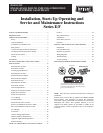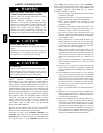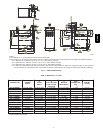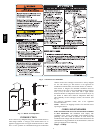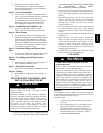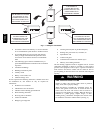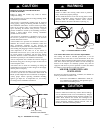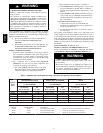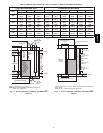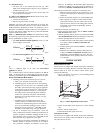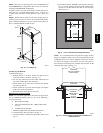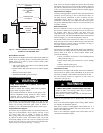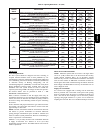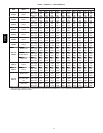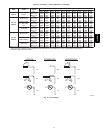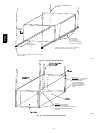
5
S National Fuel Gas Code (NFGC) NFPA
54--2009/ANSI Z223.1--2009 and the Installation
Standards, Warm Air Heating and Air Conditioning
Systems ANSI/NFPA 90B
Step 2 —General Installation
S
Current edition of the NFGC and the NFPA 90B. For
copies, contact the National Fire Protection Association
Inc., Batterymarch Park, Quincy, MA 02269;
(www.NFPA.org) or for only the NFGC, contact the
American Gas Association, 400 N. Capitol Street,
N.W., Washington, DC 20001 (www.AGA.org).
Step 3 —Combustion and Ventilation Air
S
Section 9.3 of the NFGC, NFPA 54 / ANSI
Z223.1--2009 Air for Combustion and Ventilation
Step 4 —Duct Systems
S
Air Conditioning Contractors Association (ACCA)
Manual D, Sheet Metal and Air Conditioning Contract-
ors National Association (SMACNA), or American
Society of Heating, Refrigeration, and Air Condition-
ing Engineers (ASHRAE) 2001 Fundamentals Hand-
book Chapter 34 or 2000 HVAC Systems and Equip-
ment Handbook Chapters 9 and 16.
Step 5 —Acoustical Lining and Fibrous Glass
Duct
S
Current edition of SMACNA and NFPA 90B as tested
by UL Standard 181 for Class I Rigid Air Ducts
Step 6 —Gas Piping and Gas Pipe Pressure
Testing
S
NFGC; NFPA 54 / ANSI Z223.1--2009 chapters 5, 6, 7
and 8 and National Plumbing Codes
Step 7 —Electrical Connections
S
National Electrical Code (NEC) ANSI/NFPA 70--2008
Step 8 —Venting
S
NFGC NFPA 54 / ANSI Z223.1--2009; chapters 12
and 13
ELECTROSTATIC DISCHARGE (ESD)
PRECAUTIONS PROCEDURE
FURNACE RELIABILITY HAZARD
Failure to follow this caution may result in furnace
component damage.
Electrostatic discharge can affect electronic components.
Follow the Electrostatic Discharge Precautions Procedure
listed below during furnace installation and servicing to
protect the furnace electronic control. Precautions will
prevent electrostatic discharges from personnel and hand
tools which are held during the procedure. These
precautions will help to avoid exposing the control to
electrostatic discharge by putting the furnace, the control,
and the person at the same electrostatic potential.
CAUTION
!
1. Disconnect all power to the furnace. Multiple disconnects
may be required. DO NOT TOUCH THE CONTROL OR
ANY WIRE CONNECTED TO THE CONTROL PRIOR
TO DISCHARGING YOUR BODY’S
ELECTROSTATIC CHARGE TO GROUND.
2. Firmly touch the clean, unpainted, metal surface of the fur-
nace chassis which is close to the control. Tools held in a
person’s hand during grounding will be satisfactorily dis-
charged.
3. After touching the chassis, you may proceed to service the
control or connecting wires as long as you do nothing to
recharge your body with static electricity (for example;
DO NOT move or shuffle your feet, do not touch un-
grounded objects, etc.).
4. If you touch ungrounded objects (and recharge your body
with static electricity), firmly touch a clean, unpainted
metal surface of the furnace again before touching control
or wires.
5. Use this procedure for installed and uninstalled (ungroun-
ded) furnaces.
6. Before removing a new control from its container, dis-
charge your body’s electrostatic charge to ground to pro-
tect the control from damage. If the control is to be in-
stalled in a furnace, follow items 1 through 4 before
bringing the control or yourself in contact with the fur-
nace. Put all used and new controls into containers before
touching ungrounded objects.
7. An ESD service kit (available from commercial sources)
mayalsobeusedtopreventESDdamage.
LOCATION
CARBON MONOXIDE POISONING AND UNIT
DAMAGE HAZARD
Failure to follow this warning could result in personal
injury or death, and unit component damage.
Corrosive or contaminated air may cause failure of parts
containing flue gas, which could leak into the living space.
Air for combustion must not be contaminated by halogen
compounds, which include fluoride, chloride, bromide, and
iodide. These elements can corrode heat exchangers and
shorten furnace life. Air contaminants are found in aerosol
sprays, detergents, bleaches, cleaning solvents, salts, air
fresheners, and other household products. Do not install
furnace in a corrosive or contaminated atmosphere. Make
sure all combustion and circulating air requirements are met,
in addition to all local codes and ordinances.
!
WARNING
GENERAL
This multipoise furnace is shipped in packaged configuration.
Some assembly and modifications are required when used in any
of the four applications shown in Fig. 4.
This furnace must:
S beinstalled so the electrical components are protected
from water.
S not be installed directly on any combustible material
other than wood flooring for upflow applications.
Downflow installations require use of a factory--ap-
proved floor base or coil assembly when installed on
combustible materials or wood flooring. (Refer to
SAFETY CONSIDERATIONS).
310AAV



